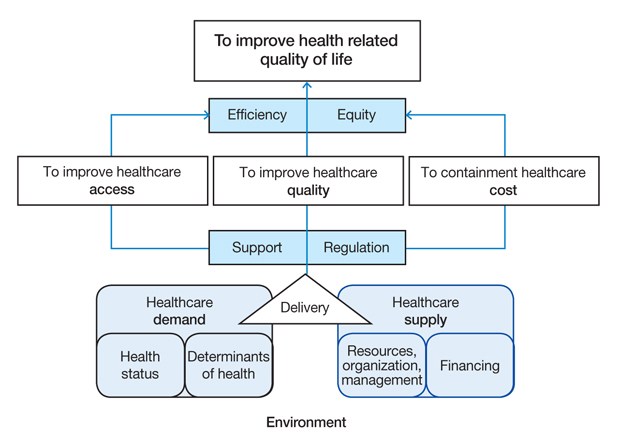The diagnosis of healthcare policy problems in Korea
- Affiliations
-
- 1Department of Preventive Medicine, Yonsei University College of Medicine, Seoul, Korea. ecpark@yuhs.ac
- 2Institute of Health Services Research, Yonsei University College of Medicine, Seoul, Korea.
- KMID: 2192813
- DOI: http://doi.org/10.5124/jkma.2012.55.10.932
Abstract
- The definition of a policy problem is important in all stages of the policy processes, and especially in presidential election seasons, which usually open the political window. We propose priorities among the policy problems of Korean healthcare by the positioning approach, which compares Korea with Organization for Economic Cooperation and Development (OECD) countries using OECD health data. The range of positioning is 1 to -1 where 1 is the best or highest level among OECD countries, 0 is the average level, and -1 is the worst or lowest level. The positioning results show that the overall health status of Korea is good (positioning=0.34), but the suicide rate (-1.00) is a major problem. Healthcare human resources are scarce (-0.46), but rapidly increasing. Hospital beds and medical equipments are over-supplied (respectively 0.37, 0.33), but medical equipments that are utilized mainly in tertiary hospitals are below average. The utilization of healthcare is at the top level in doctors' consultations (0.97) and average length of stay (0.65). The quality of in-patient care is good (0.35), but quality of out-patient care is poor (-0.36). Healthcare costs are low (-0.73), but their growth rate is high. Among healthcare costs, the policy problems are large pharmaceutical expenditures and many households with catastrophic expenditures. This study determined the priorities of healthcare policy problems in Korea. The next step is to search for the factors that influence these policy problems and develop their solutions.
Keyword
MeSH Terms
Figure
Cited by 9 articles
-
Mortality, Length of Stay, and Inpatient Charges for Heart Failure Patients at Public versus Private Hospitals in South Korea
Sun Jung Kim, Eun-Cheol Park, Tae Hyun Kim, Ji Won Yoo, Sang Gyu Lee
Yonsei Med J. 2015;56(3):853-861. doi: 10.3349/ymj.2015.56.3.853.Health policy for the new government
Eun-Cheol Park
J Korean Med Assoc. 2012;55(11):1040-1042. doi: 10.5124/jkma.2012.55.11.1040.Health policy for the new government
Eun-Cheol Park
J Korean Med Assoc. 2012;55(11):1040-1042. doi: 10.5124/jkma.2012.55.11.1040.The current status and directions of healthcare policy in Korea
Eun-Cheol Park
J Korean Med Assoc. 2012;55(10):930-931. doi: 10.5124/jkma.2012.55.10.930.Problems and future directions for quality evaluation of the Health Insurance Review and Assessment Service
Eun-Cheol Park
J Korean Med Assoc. 2015;58(3):176-178. doi: 10.5124/jkma.2015.58.3.176.Central government reform to improve national disease control
Eun-Cheol Park
J Korean Med Assoc. 2015;58(8):714-722. doi: 10.5124/jkma.2015.58.8.714.Central government reform to improve national disease control
Eun-Cheol Park
J Korean Med Assoc. 2015;58(8):714-722. doi: 10.5124/jkma.2015.58.8.714.Health policy for 20th National Assembly
Eun-Cheol Park
J Korean Med Assoc. 2016;59(10):750-752. doi: 10.5124/jkma.2016.59.10.750.Healthcare Policy Agenda for a Sustainable Healthcare System in Korea: Building Consensus Using the Delphi Method
Seung Hoon Kim, Hye Jin Joo, Joo Youn Kim, Hyo Jeong Kim, Eun-Cheol Park
J Korean Med Sci. 2022;37(39):e284. doi: 10.3346/jkms.2022.37.e284.
Reference
-
1. Park EC. Korean Society for Preventive Medicine. Health care policy. Preventive medicine and public health. 2011. Seoul: Kyechuk Munwhasa;697–700.2. Dery D. Problem definition in policy analysis. 1984. Lawrence: University Press of Kansas.3. Kingdon JW. Agendas, alternatives, and public policies. 2011. 2nd ed. Boston: Longman.4. Lalonde M. A new perspective on the health of Canadians: a working document. 1974. Ottawa: Information Canada.5. Kleczkowski BM, Roemer MI, van der Werff A. National health systems and their reorientation towards health for all: guidance for policy-making. 1984. Geneva: World Health Organization.6. World Health Organization. The world health report 2000. Health systems: improving performance. 2000. Geneva: World Health Organization.7. Aday LA, Begley CE, Lairson DR, Balkrishnan R. Evaluating the healthcare system: effectiveness, efficiency, and equity. 2004. 3rd ed. Chicago: Health Administration Press.8. Arah OA, Westert GP, Hurst J, Klazinga NS. A conceptual framework for the OECD Health Care Quality Indicators Project. Int J Qual Health Care. 2006. 18:Suppl 1. 5–13.
Article9. Organization for Economic Cooperation and Development. OECD health data 2012 [Internet]. 2012. cited 2012 Sep 21. Paris: Organization for Economic Cooperation and Development;Available from: http://stats.oecd.org.10. Organization for Economic Cooperation and Development. Health at a glance 2011: OECD indicators. 2011. Paris: Organization for Economic Cooperation and Development.11. Jung KW, Park S, Kong HJ, Won YJ, Lee JY, Seo HG, Lee JS. Cancer statistics in Korea: incidence, mortality, survival, and prevalence in 2009. Cancer Res Treat. 2012. 44:11–24.
Article12. Xu K, Evans DB, Carrin G, Aguilar-Rivera AM, Musgrove P, Evans T. Protecting households from catastrophic health spending. Health Aff (Millwood). 2007. 26:972–983.
Article13. Kang MS, Jang HS, Lee M, Park EC. Sustainability of Korean national health insurance. J Korean Med Sci. 2012. 27:Suppl. S21–S24.
Article
- Full Text Links
- Actions
-
Cited
- CITED
-
- Close
- Share
- Similar articles
-
- Priority analysis of the healthcare policy using analytic hierarchy process
- Healthcare System Needs to be Reinforced toward the Environmental Changes
- Presidential Election and Health Policy
- How to Integrate the Fourth Industrial Revolution in the Healthcare Industry?
- Current status and new policy direction of healthcare personnel in Korea


